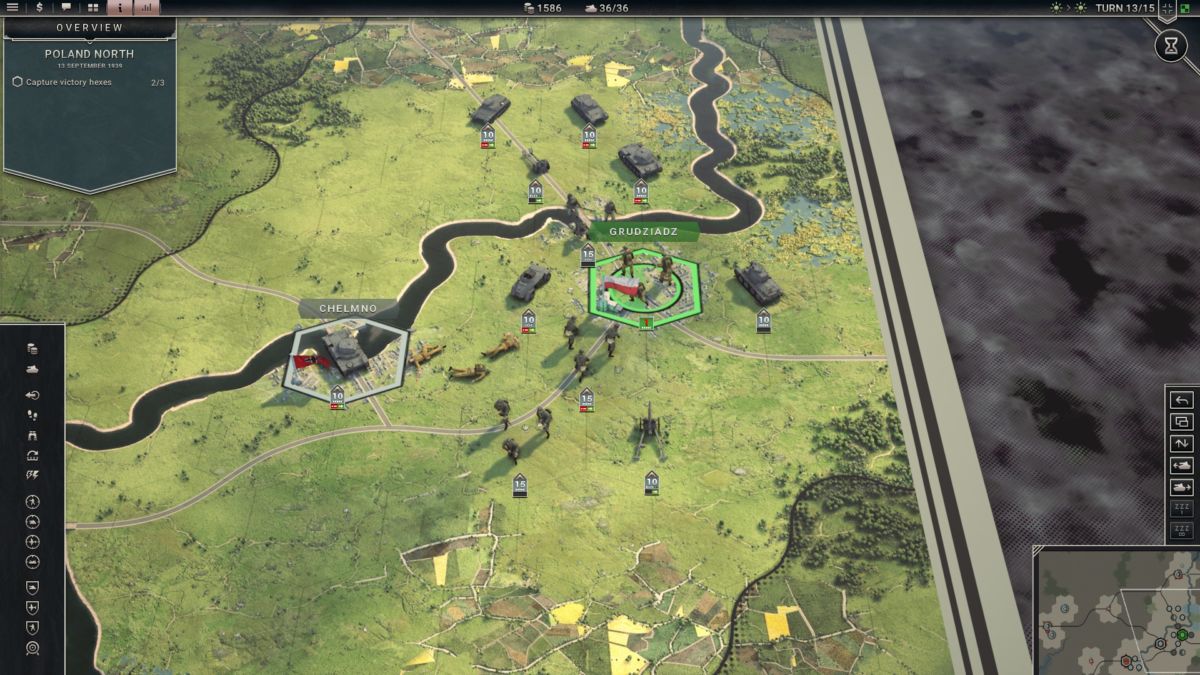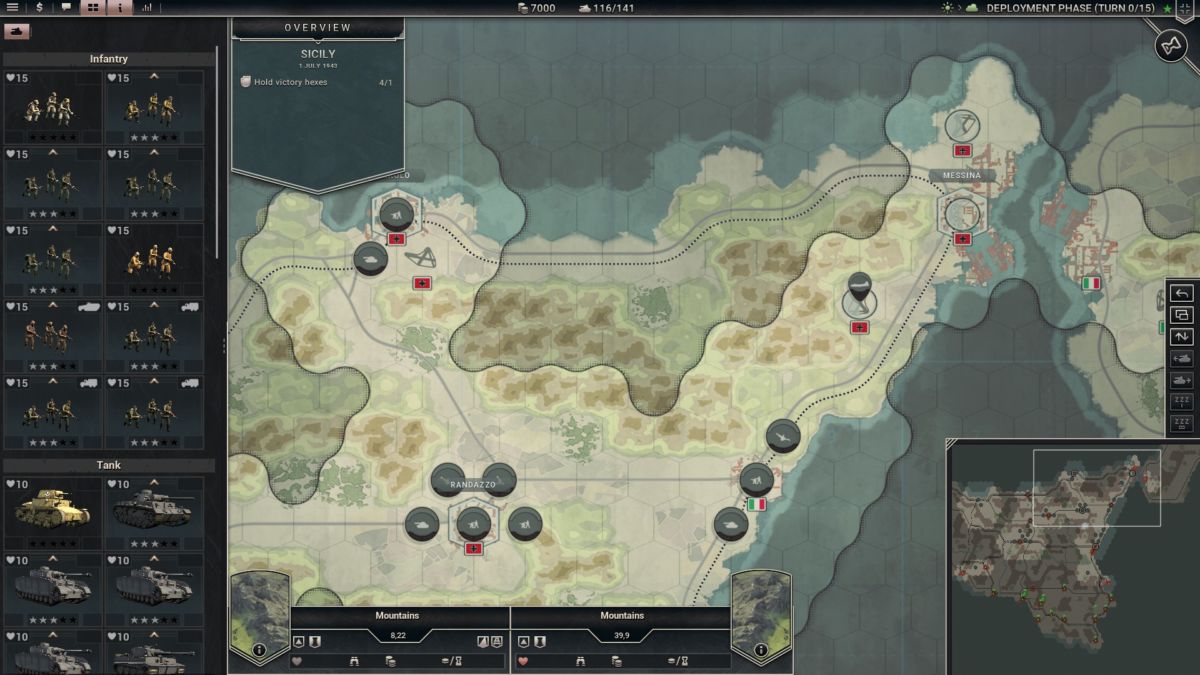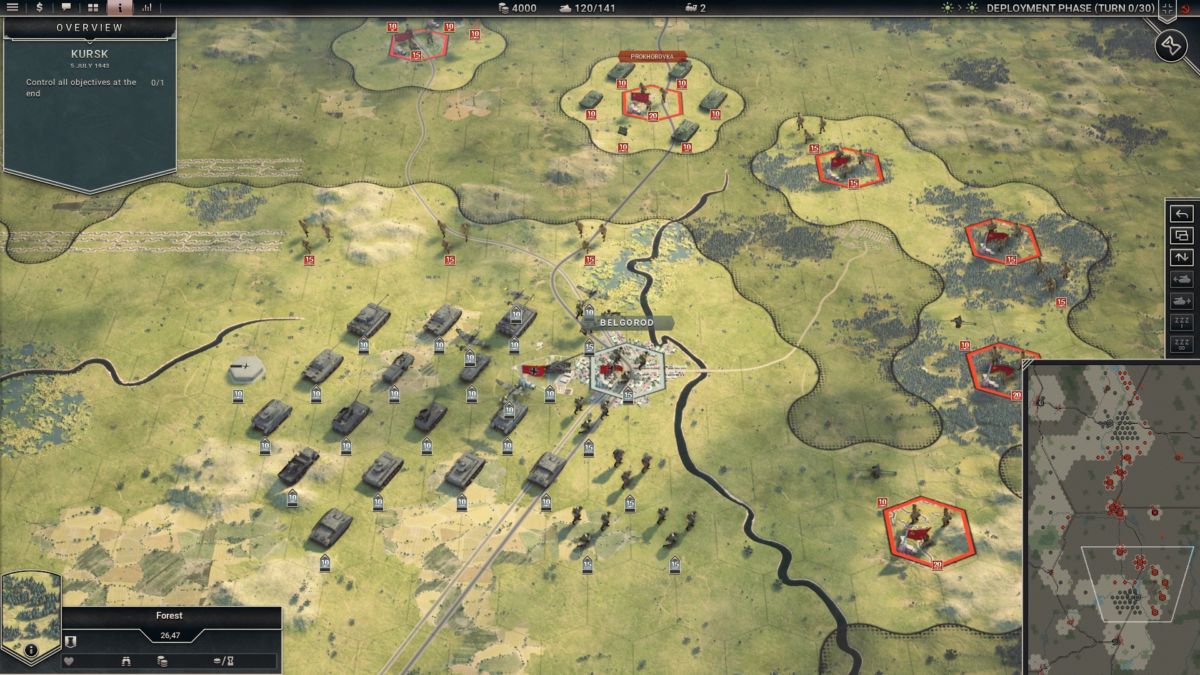
Slitherine’s flagship strategy game (now a series) has returned. Following in the footsteps of many developers and publishers updating, remastering, or evolving their games, Panzer Corps 2 follows suit with a brand new engine, mechanics and features. Panzer Corps 2, developed by Flashback Games, across the board succeeds in being a relevant and worthy update to a venerable game series. Some of the main themes of the game’s success is its adherence to a flexibility of options, gameplay approaches, and sheer volume of content.
Panzer Corps 2 is set during World War II and the overall goal of the game is to illustrate combined arms operational warfare, heavily focusing on Blitzkrieg strategy and other maneuver-focused military doctrine. The game has four varied modes which form the core experience: Persistent Campaigns, Historical and Fictional scenarios, Random Scenario generator, and a full map and scenario editor. These four modes are one of Panzer Corps’ greatest strengths. Multiplayer is also available with hotseat, play by email, and online lobby options.

The Persistent Campaigns mode gives five distinct scenarios detailing different parts of the war from the German perspective, like the Battle of Kursk or the Invasion of Poland. Each campaign has a varying number of scenarios (upwards of 20) with the possibility of branching paths based on player decisions within each mission. The persistent element of the campaigns comes from said player decisions, but also the resources players accumulate from taking objectives, as well as the units they bring.
Units, their losses, and experience will carry over from mission to mission. Furthermore, players will have the opportunity to engage in some role-playing at the beginning of a campaign as they can create their unique general avatar with a chosen portrait and traits that can significantly impact any given playthrough. This element adds a huge amount of flexibility to player choice and incentivizes multiple playthroughs trying different strategies, traits, and tactics.

The campaign mode highlights another major strength of Panzer Corps 2, which are the combat units. Units are permanent in a campaign playthrough unless destroyed and can be upgraded and reinforced from mission to mission. Players can also assign heroes that they meet to units to specialize them further, give camo skins to units, and receive awards for completing certain actions with specific units, which unlocks more stats customizing units to an even greater degree. All this allows players to seriously invest in the well-being and development of their troops, which is yet to be matched in similar wargames.
Missions typically require players to either take or hold a certain number of victory locations by a time limit. Each mission in the campaign is unique and reflects historical events and general troop dispositions. The focus on territorial control is a tried and true staple of hex-based turn-based strategy games.

There is always a chance of these types of scenarios getting stale and repetitive (one of Unity of Command’s weaknesses). However, Panzer Corps 2 avoids this problem and helps keep the simple and consistent mission design fresh. There is a healthy amount of varied offensive and defensive scenarios, as well as missions of varying sizes. For example, the Invasion of Poland missions are relatively small with up to 10-20 units, whereas the Battle of Kursk missions feature twice or three times that amount if not more per side.
Missions happen over a series of turns where players command a vast array of troop types: tanks, infantry, fighters, artillery, anti aircraft guns, bombers, and ships from across the war including prototype units. Each unit has its own set of stats and traits, which define a unit’s role. Giving orders is simple as each unit has a move action and an attack action. Due to traits, some units can move in several phases or move and attack again after eliminating units, like scout units or tanks.

The sheer amount of units present in the game gives a lot of flexibility and ability to experiment with different force compositions for completing missions. There is one small gripe regarding unit balancing, there’s very little reason to take cheaper units when resources are plentiful and more technologically advanced units become more available, which can create a situation where force compositions do not necessarily reflect historical unit availability. Functionally, this means that as new units become available, the roster of actually usable units shrinks because there is an incentive to use the most advanced units where possible. For a game concerned with modeling historically-inspired strategy and force composition, this unit imbalance can go against the game’s mission.
Panzer Corps’ simple action scheme pulls the focus of the game away from difficult and complicated actions, skills, and abilities and instead puts it on the tactical and strategic decision-making of the player. It’s a sign of a great strategy game – simplicity of action, complexity of decision and execution. In other words, Panzer Corps 2 is easy to get into and learn, but hard to master, indicating a deep well of learning potential and continuous player skill development.

In addition, the simplicity of action also focuses the player’s attention on terrain, unit positioning, and how to use all their forces optimally to reach their objectives. Not to mention that the simple action system makes the game fast-paced and snappy even on massive maps with large numbers of units. All of these conditions make the experience more rewarding, as players can learn something new about how various factors interact with one another and how to best achieve victory after every match.
Missions themselves have a significant element of dynamism due to several factors. Combat includes a minor element of RNG, so the effect of an attack can never be predicted with absolute certainty. During missions, players can upgrade and call in new units based on the objectives they complete, which means that not only does the player’s army evolve over time strategically, but also during the middle of an operation. And finally, the AI is quite good and will aggressively attack the player’s weakest units to do its best in delaying player progress.

Regarding the other modes, Historical and Fictional scenarios are single missions with their own non-persistent victory conditions and units. The random scenario and map generator has a wide range of options for generating all sorts of maps for players to try something non-historical and crazy with WWII units. And finally, the scenario editor is quite extensive and gives players the option to create their own missions, providing them the option to exercise their creativity and pour yet more hours into an already content rich game.
When players select a campaign or mission, they can customize their experience with five difficulty levels that mostly affect resource availability rather than AI behavior. Moreover, to add yet even more flexibility to player control, missions have an advanced options section where they can customize conditions even further, like harsher fog-of-war or even more restrictions on resources. It’s almost like this game is open source without being open source in how much flexibility players have in their modes and gameplay approach.

For anyone familiar with the original Panzer Corps, the most noticeable change between it and the sequel is the upgrade to a new 3D-graphics capable engine. It seems that a lot of Slitherine strategy games and other indie wargame developers are following this trend of transitioning to 3D engines. Panzer Corps 2 isn’t anything to write home about graphically, but it’s pleasant to look at with terrain being clearly defined, and units even having various environmental effects reflect the weather, like traces of snow on vehicles on snow maps.
One of the biggest improvements with the new engine is an updated and sleeker UI. Most menus are easily accessible and usually don’t clutter up the screen too much. Also, when accessing menus, the UI shifts and moves with satisfying smoothness. UI design has been a significant point of criticism of Slitherine games in general, like the original Panzer Corps or Pike and Shot: Campaigns, in that the UI would usually be unforgiving and clunky. With Panzer Corps 2, it seems Slitherine-published games are starting to integrate better UI, which makes the game even more accessible.

One minor gripe about the UI concerns comparing unit stats between enemy and allied units. In the unit purchase menu, players can easily see the difference between unit stats as they are color-coded green or red. This is not a feature when comparing friendly unit stats to enemy units, which seems like an important and odd oversight.
Speaking of accessibility, the game includes an extensive tutorial mode with a simple tutorial campaign that shows the basics of unit behaviors, actions, and traits, as well as a large list of challenge missions, which helps players hone their skills and get a better understanding of the game. The options menu is also surprisingly extensive for a not so heavily taxing game with a number of important sliders for audio and a decent array of graphics options. The real standouts are the hotkey rebinding menu, as well as an entire UI options section where players can customize the UI to their liking, yet again giving more control, not just in gameplay, but in how the game looks.
The audio design is a bit of a mixed bag. While the music is thematic and certainly evokes heroism and the period, it can get repetitive as I didn’t feel that any of the tracks stood out and I also noticed that some tracks looped one too many times. Weapon sound effects, such as machine guns firing and armor-piercing shells clanking on armor, are good enough, but some effects are clearly stock or old and can give the game a bit of a sloppy or unpolished feel to it, especially compared to the pleasing graphics and good UI. On a positive note, during the campaign, players will be aided by a general who will brief them for each mission. The voice acting is quite good and the dialogue gives even the briefings some character rather than just bland text (though there is some of that too).
Performance-wise, the game ran well (running an i9-9900K CPU and RTX 2080Ti GPU) and it’s safe to assume that Panzer Corps 2 will run smoothly on older generation hardware as well. I haven’t encountered any significant bugs or crashes, with only some placeholder text and awkward English wording. There were some odd frame drops and input lag in the unit purchase menu during missions, especially when there were a lot of units available, so there is definitely room for performance optimization and patching.
Panzer Corps 2 is absolutely stacked with content and the value proposition given its cost is quite reasonable. There is an inherent content versus price advantage that strategy games have, especially in the vein of Panzer Corps hex wargames, and Panzer Corps 2 is no exception. The game itself is very good, with the series’ core mechanics staying the same with it only getting better with some new additions, like heroes and unit awards. This is a wholehearted recommendation to go out and get Panzer Corps 2 for any strategy game fans, enthusiasts, and even newcomers to the genre.
A copy of Panzer Corps 2 was provided by PR for the purposes of this review.
Some of the coverage you find on Cultured Vultures contains affiliate links, which provide us with small commissions based on purchases made from visiting our site.


